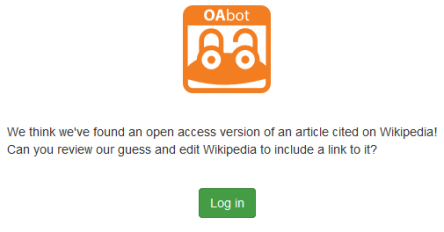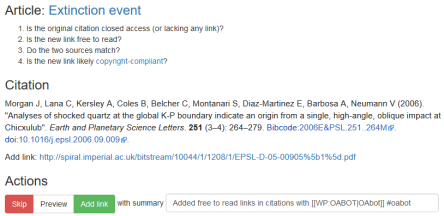I was recently contacted by science journalist Elie Dolgin, who wanted my thoughts on Willinsky and Rust‘s funder-library OA subscription model. Here are his questions and my responses, published here to complement the article he wrote: A fix for open-access cost barriers: what if funders and libraries paid processing fees instead of authors?
Whether this model is indeed better than the current OA system reliant on article processing charges?
The main attraction of this model is that it removes the paywall, rather than readers paying to read content (whether paying individually or via library/other subscriptions). One aim of Open Access is to remove paywalls to readers, and the proposal achieves this.
However, most advocates of Open Access aim higher than just removing the paywall; their goal is for OA research materials to have more generous re-use rights too. Traditional commercial publishers have strict rules about what readers may do with articles/information they access. For example, it is usually forbidden to pass on a legitimately-accessed PDF of an article to a friend or colleague. On the one hand, this is intended to strictly limit access to subscribers only, but it can also prohibit passing on the PDF to a colleague at the same institution, or posting the PDF on the institution’s virtual learning environment, even though in both cases the beneficiaries are also legitimate subscribers.
Furthermore, OA aims for more permissive sharing rights than those allowed under traditional licence arrangements. There is emphasis on attribution (such as in a
CC-BY licence), and re-use rights would include being allowed to use longer extracts, and to perform text and data mining on the article or dataset. This is really important for
reproducibility studies, and for
Cochrane-style reviews where data from multiple studies is examined.
This model does not appear to challenge restrictive sharing and re-use practices.
What, if anything, appeals to you about John’s suggestions?
In my experience, many staff in libraries have a (small c) conservative approach to transformative approaches or technologies. They often operate in complicated organisations where it is difficult to effect change quickly, budgets are tight, and they want to be able to give their readers and researchers access to the widest possible range of materials and information sources. John’s suggestions represent an approach to funding academic publishing which goes some way towards achieving (some goals of) Open Access, without being a radical proposal that will make academics nervous.
Any criticisms?
As just mentioned, this is not a radical (“change at the root”) solution. Part of the OA movement is about opening up access to and re-use of scholarly materials, and there is a parallel and often overlapping issue which is the costs of subscriptions. It is suspected by many that the high profitability of many publishers, and that they make this profit from journal articles for which they pay researchers or their universities no fee, is unethical and an unwise use of (often public) funds. I take care to point out that this issue is separate from the OA movement, although some of the goals are shared.
To someone who sees profits being made from the free (to publishers) labour of researchers, squeezed library budgets, and increasing journal subscription costs, John’s proposal does nothing to address the issue from this side: it merely shifts the costs to libraries (and other subscribers) from pay-to-read to pay-to-subscribe-to-support. In this way, the OA subscription model is possibly cheaper than the APC model, but it does not increase transparency in the costs of publishing and help the costs to fall, or the perceived value-for-money to increase and therefore justify the costs of publishing.
Do you buy the argument that funders and libraries will have more bargaining power to lower processing fees, or is this just shuffling money in a different way?
In my experience, libraries have very little bargaining power, as they generally have to accept the price asked by the publisher, or lose the subscription and have to deal with lots of unhappy academics. Consortia at regional or national level can enter into collective bargaining if they stick together to exert the necessary pressure, but this is the same for any charging mechanism, whether this new model or the traditional subscription. Competition between universities is intense, and this can erode the solidarity needed for a collective bargaining model to work effectively.
What is different about this model is whether libraries lose out if they do not subscribe – if the resources are OA anyway, the publishers will have to come up with other benefits to the subscribing institution of carrying on their membership. This is especially important if subscriptions are to continue in the face of further pressure on budgets, where libraries will look to cut anything perceived as non-essential. It is not yet clear to me how such library-funded OA platforms can count on supporters to stay involved – see also
Open Library of Humanities which uses a similar model, called Library Partnership Subsidy (LPS).
The novelty of this proposal and why it could put OA publishing on a more sustainable footing
It is novel in that it flips the costs to libraries from pay-to-read to pay-to-subscribe-to-support. I am not sure about its contribution to making OA publishing more sustainable, as it is tangled up in this other issue of publishing costs.
Personally, I would favour a more radical approach, in which we consider how knowledge is produced, shared, and remixed – in the age of the internet. For example, what about a distributed network of document/dataset/other servers connected by search interfaces, with persistent identifiers for items (
DOIs), people (
ORCID iDs), and organisations, and metrics such as
altmetrics to assess the reach, endurance, and citation impact of each item? This would build a new research information ecosystem, allowing knowledge to network and flow easily, and not perpetuate the limits of print-based media in a digital environment. It would also challenge the legacy publishing model which keeps researchers locked in to publishing in expensive journals through the use of their elite names (e.g. “everyone wants to publish in Nature”) and commercial products such as
Impact Factor.



![Arrival: have ORCID@5 video playing https://vimeo.com/238076634 | Introductions: people introduce themselves and tell the group about their role in the project | Canapés: guided tour of Welcome to ORCID https://orcid.org/help | Refreshments: serve virtual drinks e.g. [Gabriela served an ORCIDinha to Laura], and people share any dressing up or drinks/snacks they’ve prepared for the party | Tapas: tour of outreach resources http://members.orcid.org/outreach-resources | Entertainment: play Why ORCID? video https://vimeo.com/237730655 | Thank guests, and close.](https://darkarchive.files.wordpress.com/2017/10/menu.png?w=444&h=604)



